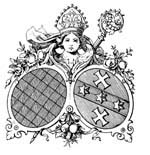
Modern Catholics: Don’t Knock the Miraculous Medal!
MORE THAN STRANGE COINCIDENCES
When I was teaching English at Christendom College in Front Royal, Virginia, I received a telephone call one evening in early June 1992 from close friends in Iowa, Frank and Jane Ellen Colella. As we exchanged news, Jane Ellen mentioned Frank’s recent visit to France with other faculty and students from Simpson College (where Frank is a professor of economics). On a spontaneous excursion that was not scheduled on the itinerary, Frank had meandered to the Chapel of the Miraculous Medal on the Rue de Bac in Paris where the body of St. Catherine Labouré lies incorrupt. Frank remembered his visit to the chapel as the highlight of his tour of Paris, and he purchased several of the Miraculous Medals at the gift shop for family members.
Frank’s experience had piqued my interest in this particular saint who, compared to the more famous saints I had studied (Augustine, Thomas Aquinas, Francis de Sales), was relatively unknown to me. In fact, I felt somewhat guilty and embarrassed at my ignorance and told myself that I needed to learn more about her life.
A few days afterwards, I visited the Seton Home School, also in Front Royal, to collect English tests and papers that I was grading for part-time work. On one of the desks I noticed Mary Fabyan Windeatt’s biography of the saint, published by TAN Books. Even though it was a simple children’s version of St. Catherine Labouré’s life, I felt compelled to read it, and asked for permission from Mrs. Mary Kay Clark, director of the Seton Home School, to borrow the book.
Immediately engaged and spellbound, I read the book in a few sittings. I admired the simple, modest, pious life of St. Catherine’s parents, their generosity in raising a large family with small means, and their great love of the Catholic faith, which they transmitted in all its fullness to each of their children. When I read about the visitations of the Blessed Mother to Catherine when she was in her religious order, the Daughters of Charity, and then read of all the cures and miracles effected by the Miraculous Medal, I felt an overwhelming desire to acquire such a medal. The powerful image of the Blessed Mother with beams of light radiating from her outstretched hands to symbolize the abundant graces that Christ dispenses through His holy mother’s Immaculate Heart stamped itself upon my memory as indelibly as it was impressed upon the medal. As I finished the book, the message of the Blessed Mother to St. Catherine echoed in my mind: As the Mother of us all, Mary desires all her children to seek the many graces that she will generously pour upon all of them. Yet, as she lamented to St. Catherine in one of the visitations, these abundant graces are not fully dispensed because they are seldom sought in prayer; many beams of light go unclaimed and never touch human lives.
You May Also Enjoy
Reviews of Catholic Women Writers: A Bio-Bibliographical Sourcebook... Carry A. Nation: Retelling the Life
When one considers the sublime fine-tuning of the universe as Denton describes it, the conclusion of a Designer is hard to resist.
Archbishop Levada: Call Your Office!... An Embarrassment of Martyrs... An Inexplicable Apology... Monkey See, Monkey NOT Do?

